Even if you've never made bread before, you'll love this spiced fruit buns recipe, The dough is flavoured with cinnamon, orange and vanilla, enriched with butter and milk and studded with plump mixed fruit to give a beautifully soft and aromatic crumb.
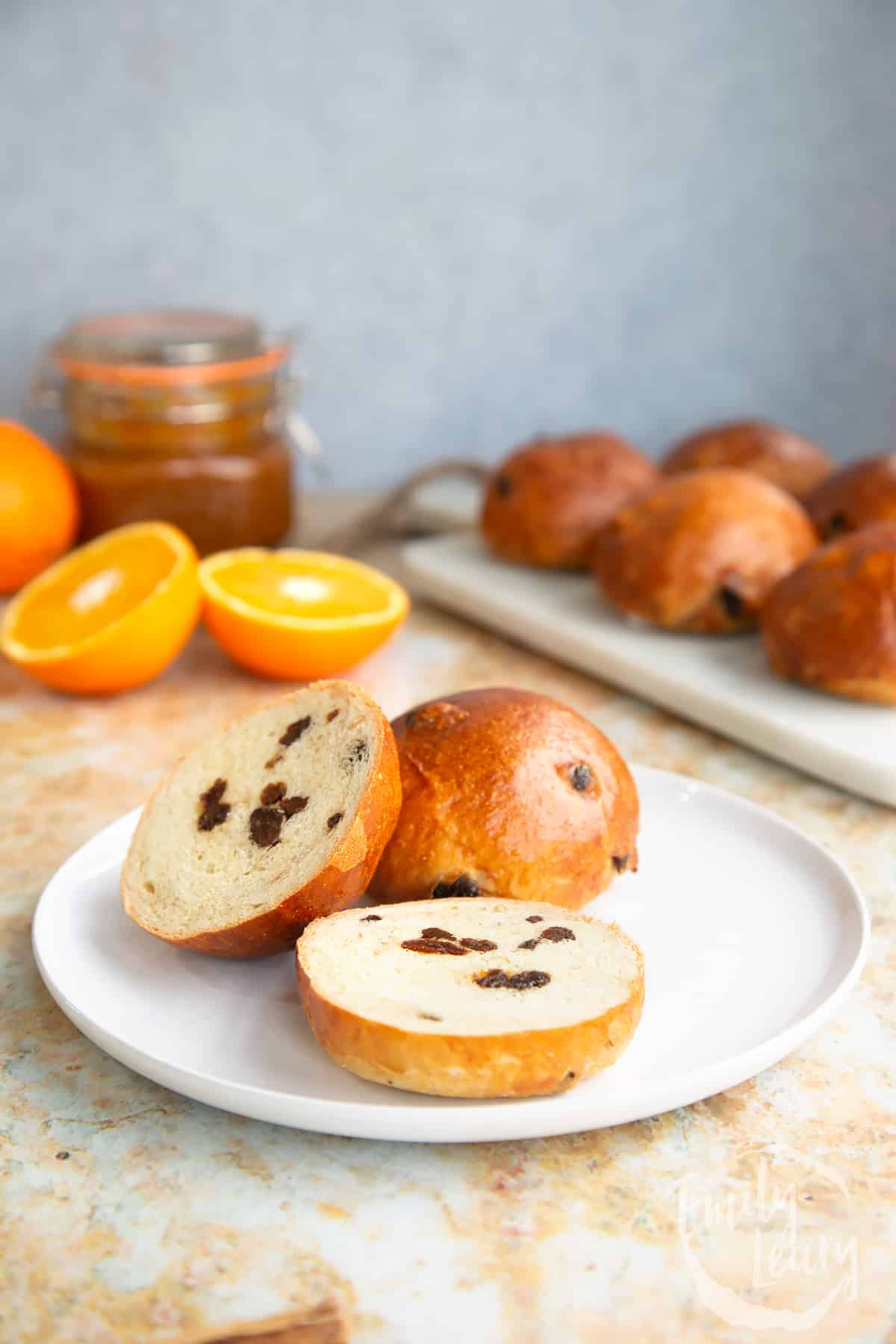
These spiced buns are great served in all sorts of ways: as they are, toasted with butter, or you could even go down the savoury route with a slice of mature cheese!
To make them, you'll start by warming milk with orange peel, cinnamon sticks and a vanilla pod, then add butter and leave to let all the flavours infuse into the liquid.
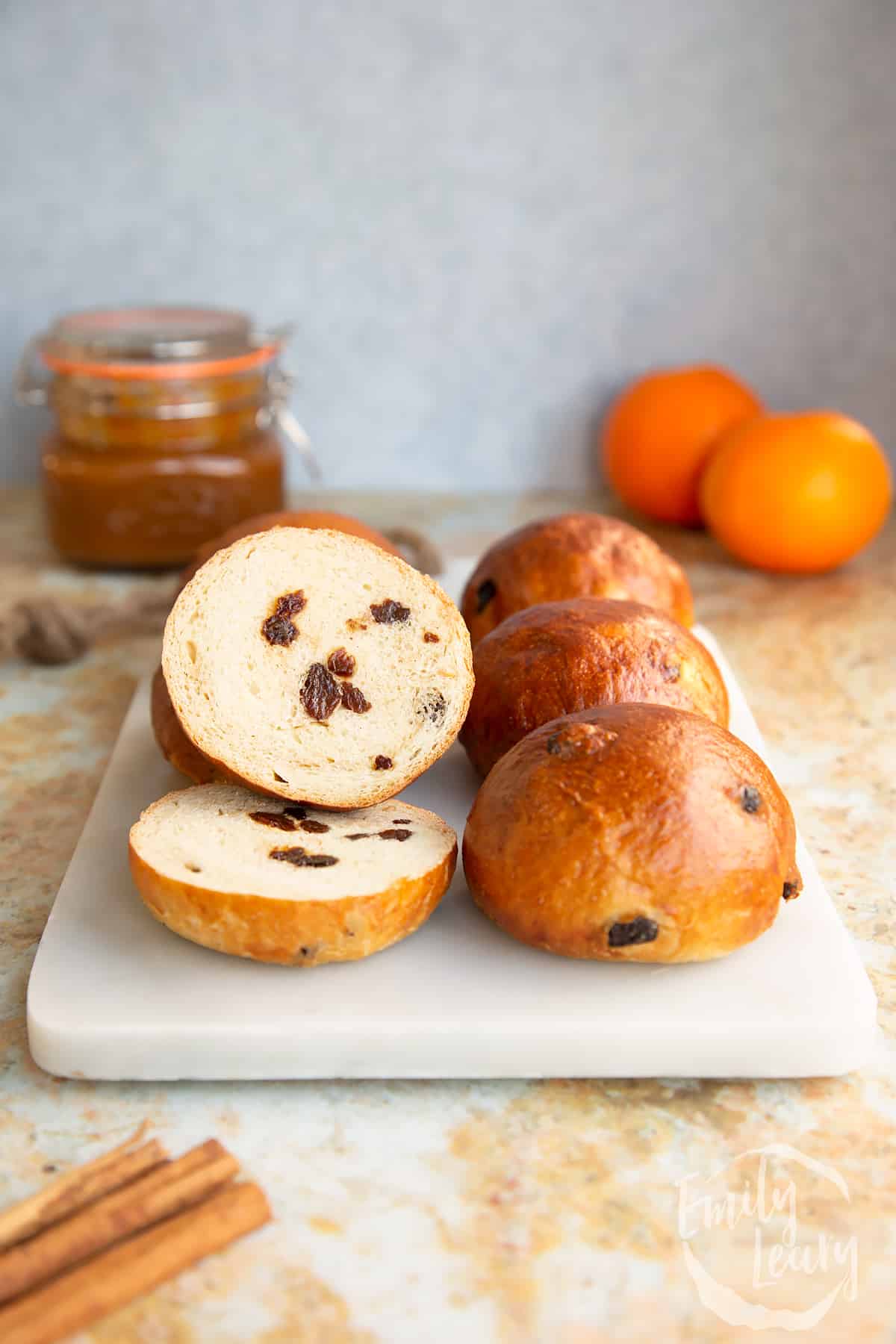
Next you'll combine bread flour, yeast, brown sugar and salt and then stir in the liquid to form a lovely soft dough, which you'll knead until smooth, then leave to prove.

Once risen and full of air, you'll knock the dough back and knead in some soaked mixed fruit before dividing the dough into 10 rolls ready for a second prove. After that, it's just a case of brushing with egg until golden brown and smelling incredible.
Here's what to do to make these soft, delicious spiced fruit buns.
Ingredients
For the milk
- 350 ml (1¾ cups+ 2 tbsp) whole milk
- 1 orange peeled, avoiding the white pith as much as possible
- 1 cinnamon stick
- 1 vanilla pod split and seeds released
- 75 g (5 tbsp) salted butter plus extra to grease
For the dough
- 500 g (3⅓ cups) strong white bread flour
- 50 g (5 tbsp) soft light brown sugar
- 1 ½ tsp (1½ tsp) fast action yeast
- 1 tsp salt
- 150 g (¾ cup) dried mixed fruit
- 1 medium free range eggs lightly beaten
Instructions
Scald and infuse your milk
Place your milk, orange zest, cinnamon stick and vanilla pod in a small saucepan over a low-medium heat. Bring it almost to boiling point, with steam starting to form and bubbles appearing around the edge of the pan, then take off the heat. Scalding is an important step as milk contains an enzyme that can stop your gluten from developing but you don’t want to boil it as you’ll start to lose liquid.

Add the butter to the milk and leave to cool.
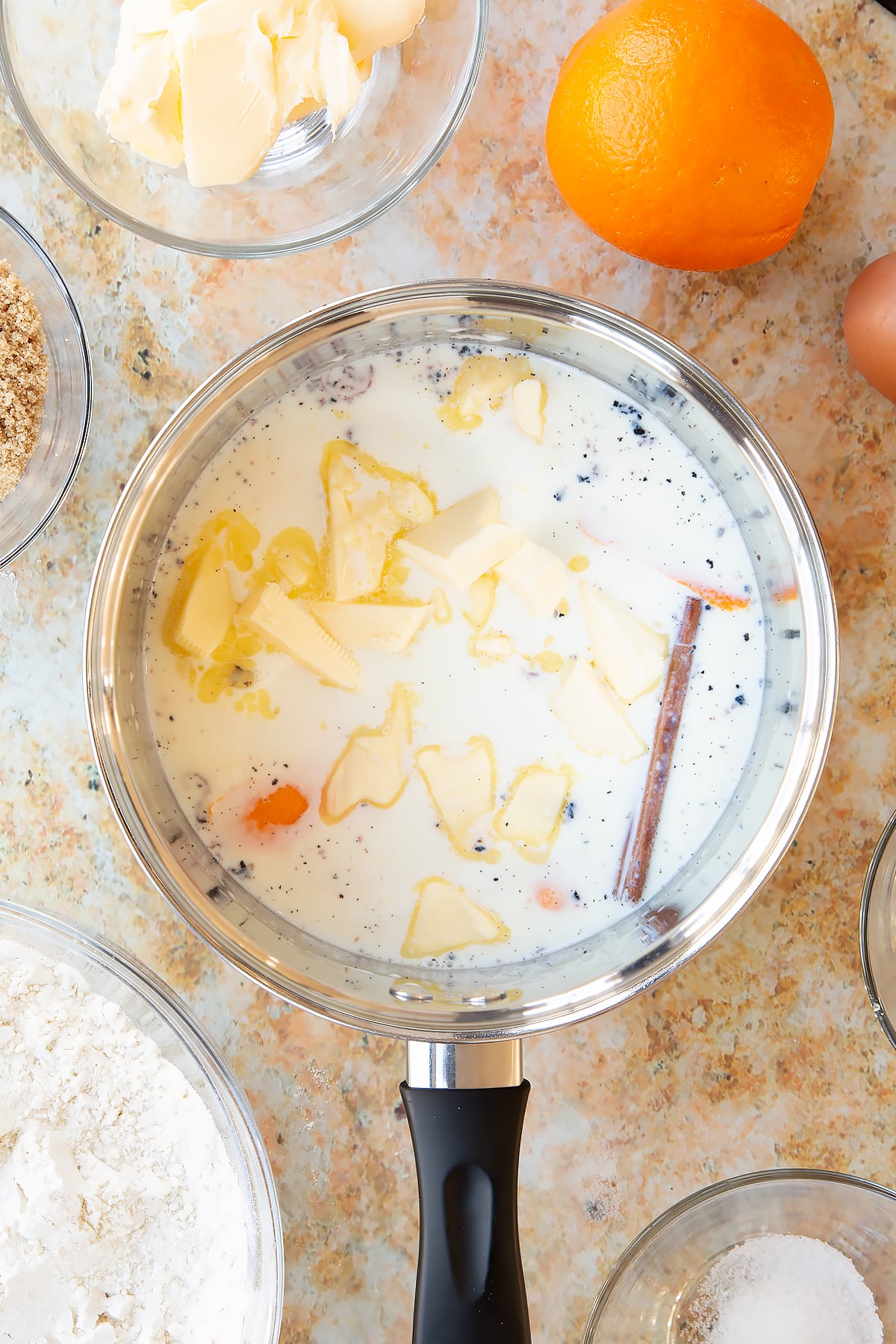
It mustn’t be too hot when it goes into the dough or it will kill the yeast. “Blood temperature” is ideal, so no more than 37C (98.6F).

Strain through a sieve to remove the additions.
Make your dough
Put the flour, sugar, yeast and salt in a large bowl.

Stir together.

Pour in two thirds of the milk mixture.
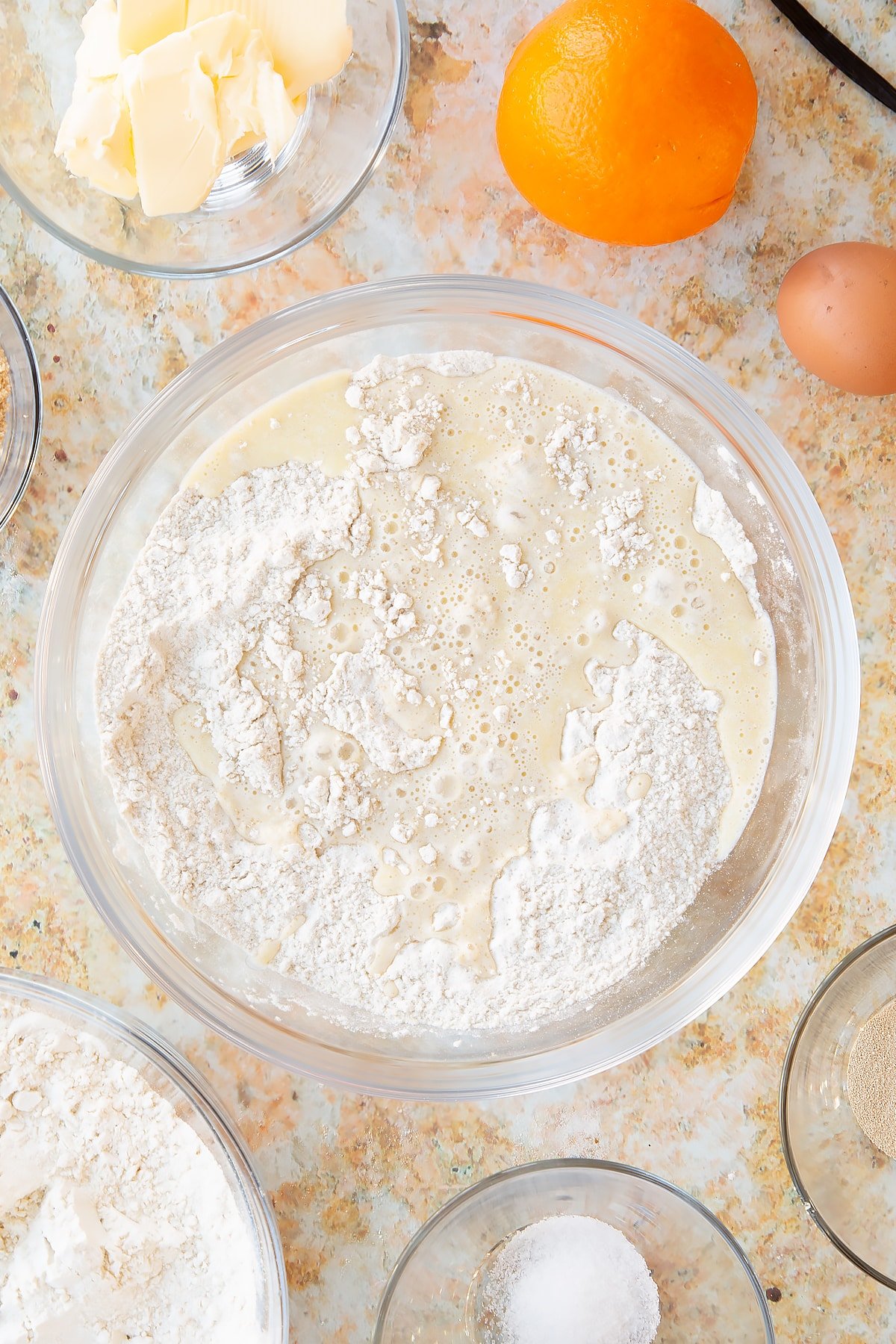
Stir together. Keep adding the milk little by little to any patches of loose flour until the dough comes together in a clump on the spoon with no loose flour on the bottom.

You might not need all the milk mixture.
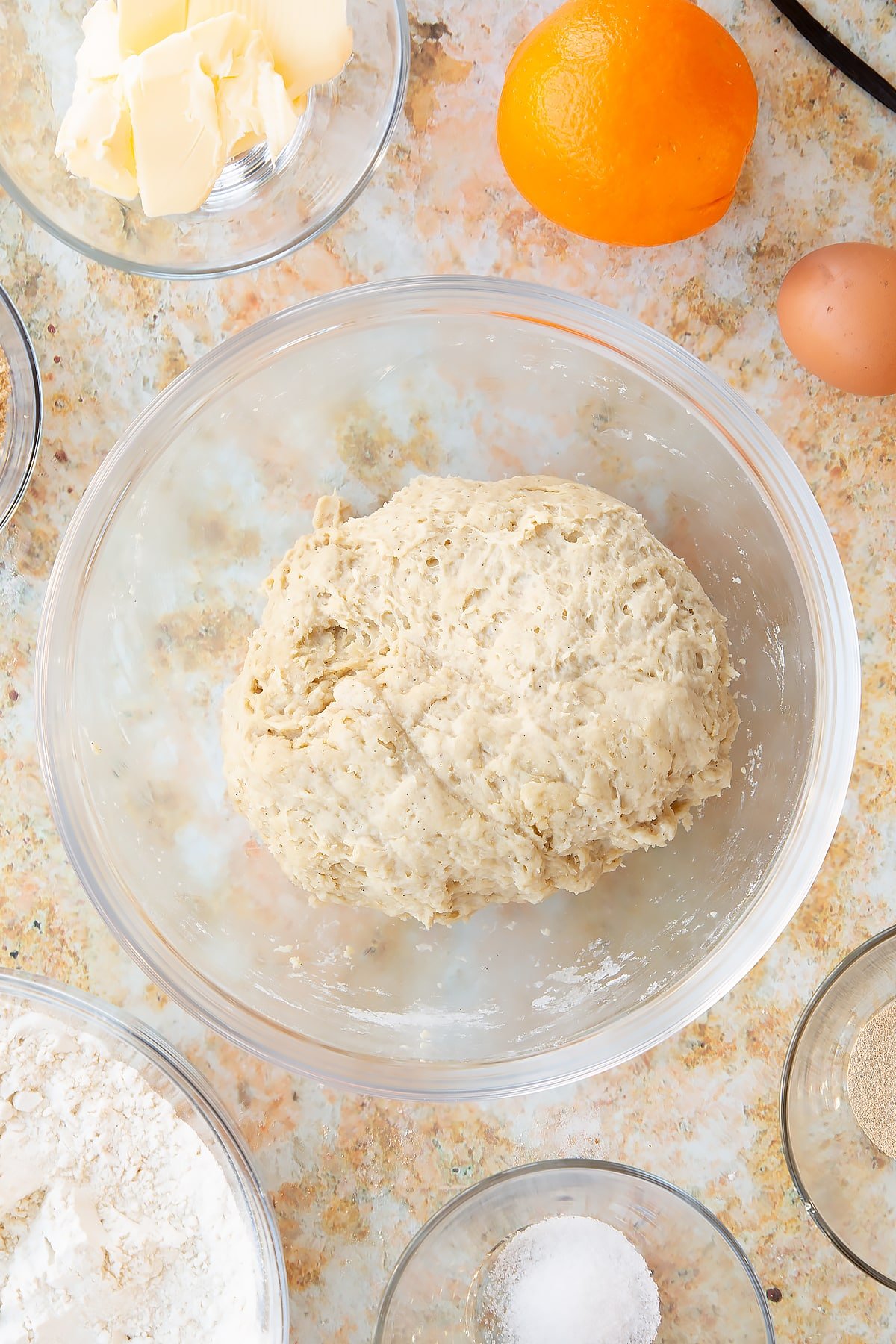
Tip the dough on a very lightly floured surface and knead for about 8 minutes, stretching and folding the dough until you have a smooth, elastic texture that springs back when pressed.

Form the dough into a ball and place in a lightly oiled bowl. Cover and leave to prove in a warm place for 1-2 hours until doubled in size.

Shape your rolls
Put the mixed fruit in a small bowl and add freshly boiled water to just cover the contents. Soak for 5 minutes, then drain away any excess. Soaking in this way makes the fruit less prone to burning in the oven.
Line two trays with baking paper and place clean tea towels on top.
Tip the dough onto a clean surface.

Press out to about 2.5cm (1 inch) think and then sprinkle the mixed fruit on top.

Knead a few times until the fruit is incorporated - try not to overwork the dough more than necessary.

Weigh the dough, then divide into 10 equal pieces - mine were 105g (3.7oz) each but it will depend how much liquid you added when making the dough.

Cover the pieces with a tea towel and let them rest for 10 minutes.

Take a piece of dough and bring the sides up into the middle, pinching to hold. Flip the dough to reveal the smooth side and now press your palms together underneath the dough to create more tension on top. Place on a lined tray under the tea towel. Repeat for all the rolls

Leave for in a warm place for about 45 minutes - 1 hour until doubled in size. You can test if they’re fully proved by pressing a finger into one roll in an inconspicuous spot. If it stays dented, the bread has proved.

Bake your rolls
Heat the oven to 180C (160C fan, 350F), then remove the tea towels and brush each roll gently with beaten egg. Avoid getting too much on the brush so that you don’t end up with drips that will show up after baking.
Bake in the oven for 25 minutes until the rolls turn a gorgeous, golden brown on top and sound hollow when tapped underneath. The rolls on the lower shelf may need a minute or two longer than the ones on the top shelf.

Transfer the rolls to a wire rack to cool completely.

They're soft and delicious and taste amazing as they are, or toasted and served warm with butter.
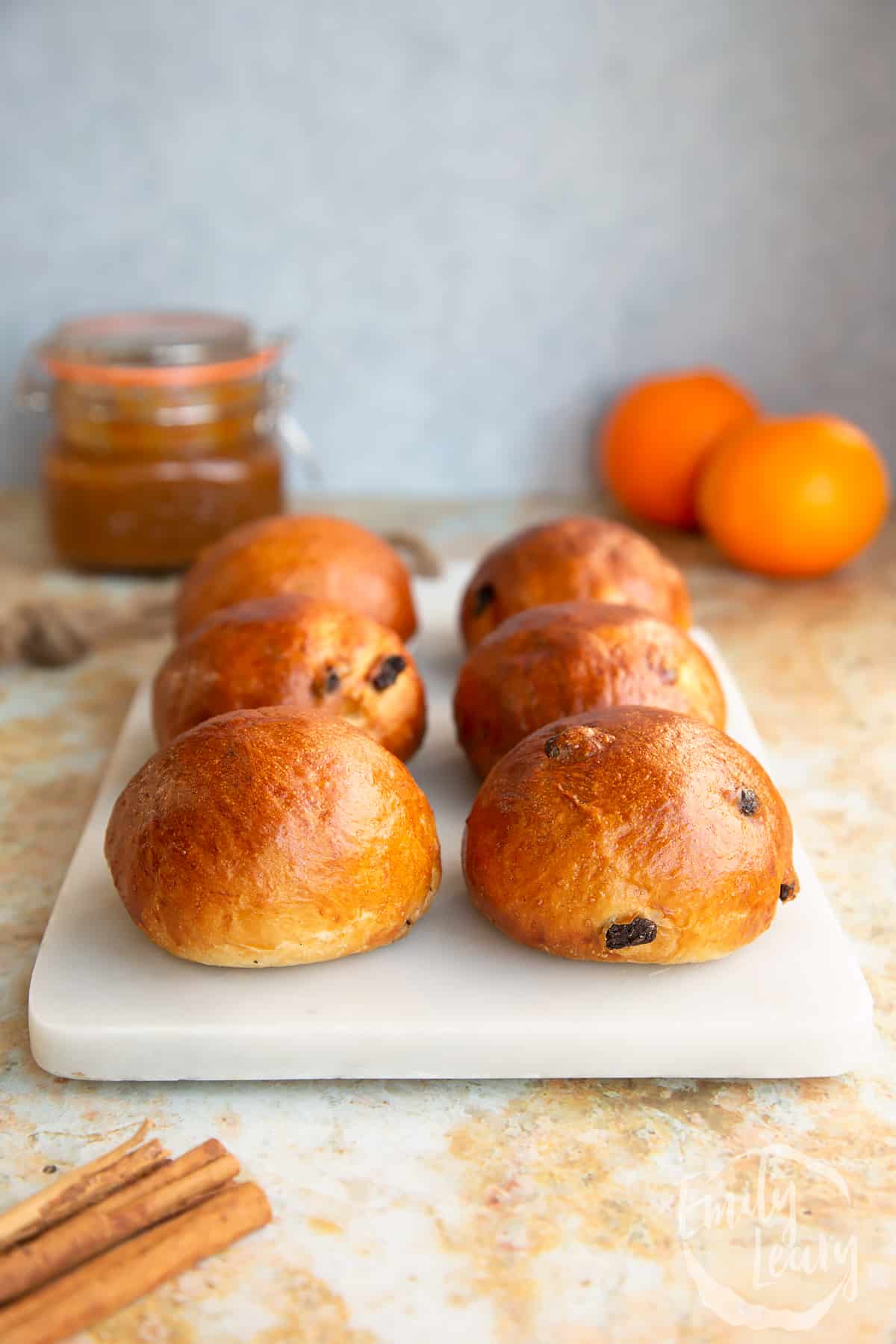
Store well wrapped in the bread bin to keep them fresh. What did you think of these deliciously spiced fruit buns?

Print this spiced fruit buns recipe
Spiced Fruit Buns Recipe
Ingredients
For the milk
- 350 ml (1¾ cups+ 2 tbsp) whole milk
- 1 orange peeled, avoiding the white pith as much as possible
- 1 cinnamon stick
- 1 vanilla pod split and seeds released
- 75 g (5 tbsp) salted butter plus extra to grease
For the dough
- 500 g (3⅓ cups) strong white bread flour
- 50 g (5 tbsp) soft light brown sugar
- 1 ½ tsp (1½ tsp) fast action yeast
- 1 tsp salt
- 150 g (¾ cup) dried mixed fruit
- 1 medium free range eggs lightly beaten
Instructions
Scald and infuse your milk
- Place your milk, orange peel, cinnamon stick and vanilla pod in a small saucepan over a low-medium heat.
- Bring it almost to boiling point, with steam starting to form and bubbles appearing around the edge of the pan, then take off the heat. Scalding is an important step as milk contains an enzyme that can stop your gluten from developing but you don’t want to boil it as you’ll start to lose liquid.
- Add the butter to the milk and leave to cool. It mustn’t be too hot when it goes into the dough or it will kill the yeast. “Blood temperature” is ideal, so no more than 37C (98.6F).
- Strain through a sieve to remove the additions.
Make your dough
- Put the flour, sugar, yeast and salt in a large bowl. Stir together.
- Pour in two thirds of the milk mixture and stir together. Keep adding the milk little by little to any patches of loose flour until the dough comes together in a clump on the spoon with no loose flour on the bottom. You might not need all the milk mixture.
- Tip the dough on a very lightly floured surface and knead for about 8 minutes, stretching and folding the dough until you have a smooth, elastic texture that springs back when pressed.
- Form the dough into a ball and place in a lightly oiled bowl. Cover and leave to prove in a warm place for 1-2 hours until doubled in size.
Shape your rolls
- Put the mixed fruit in a small bowl and add freshly boiled water to just cover the contents. Soak for 5 minutes, then drain away any excess. Soaking in this way makes the fruit less prone to burning in the oven.
- Line two trays with baking paper and place clean tea towels on top.
- Tip the dough onto a clean surface, press out to about 2.5cm (1 inch) think and then sprinkle the mixed fruit on top. Knead a few times until the fruit is incorporated - try not to overwork the dough more than necessary.
- Weigh the dough, then divide into 10 equal pieces - mine were 105g (3.7oz) each but it will depend how much liquid you added when making the dough.
- Cover the pieces with a tea towel and let them rest for 10 minutes.
- Take a piece of dough and bring the sides up into the middle, pinching to hold. Flip the dough to reveal the smooth side and now press your palms together underneath the dough to create more tension on top. Place on a lined tray under the tea towel.
- Repeat for all the rolls
- Leave for in a warm place for about 45 minutes - 1 hour until doubled in size. You can test if they’re fully proved by pressing a finger into one roll in an inconspicuous spot. If it stays dented, the bread has proved.
Bake your rolls
- Heat the oven to 180C (160C fan, 350F), then remove the tea towels and brush each roll gently with beaten egg. Avoid getting too much on the brush so that you don’t end up with drips that will show up after baking.
- Bake in the oven for 25 minutes until the rolls turn a gorgeous, golden brown on top and sound hollow when tapped underneath. The rolls on the lower shelf may need a minute or two longer than the ones on the top shelf.
- Transfer the rolls to a wire rack to cool completely.
Video
Nutrition
Pin this spiced fruit buns recipe

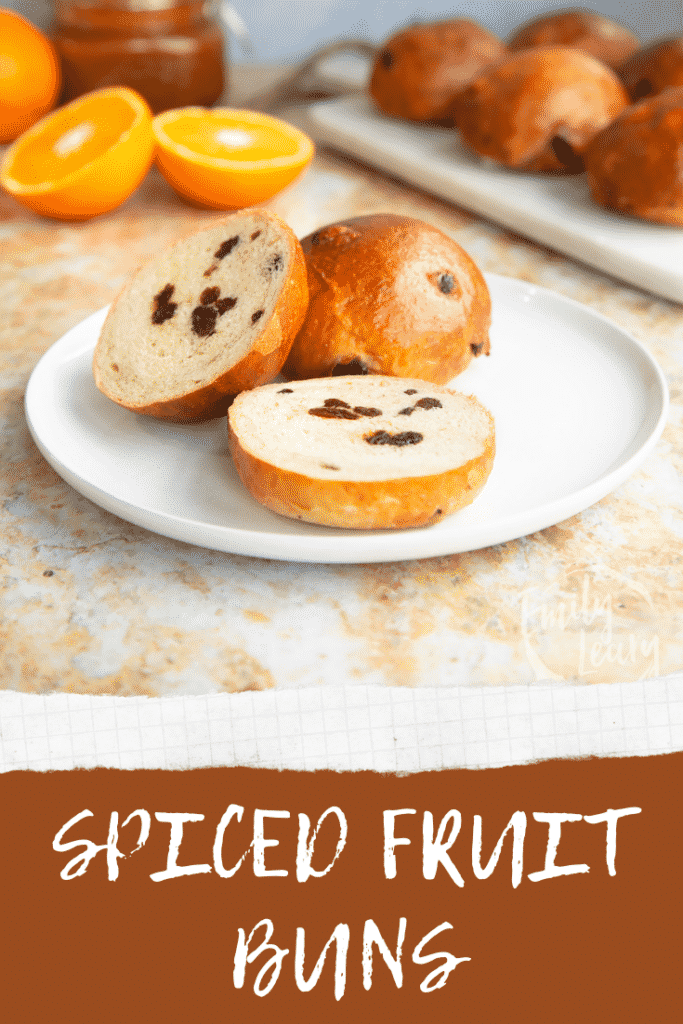


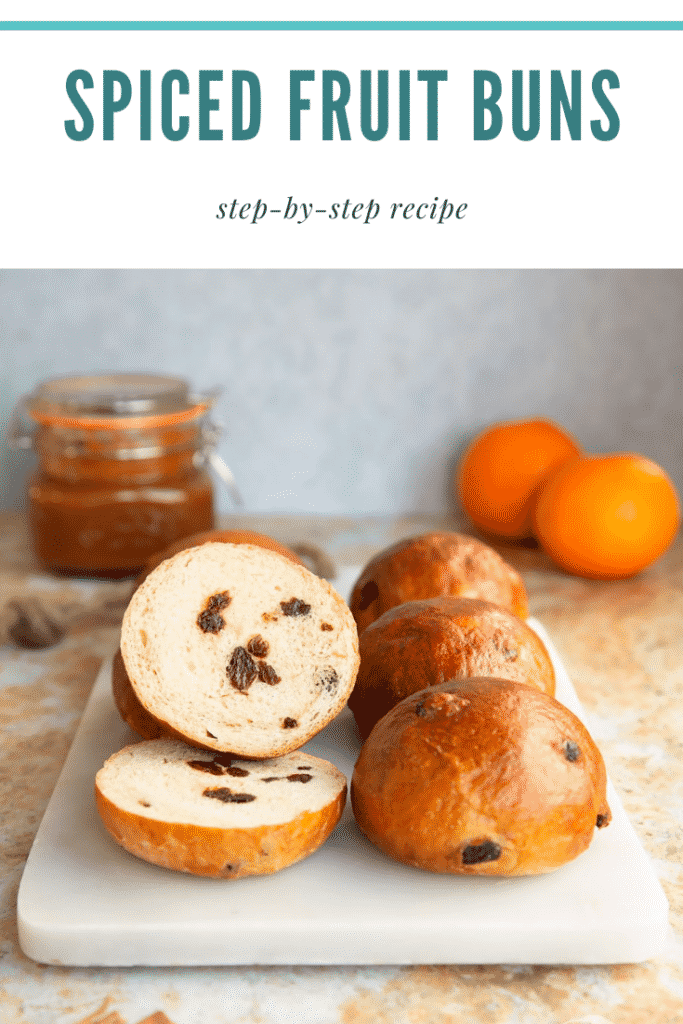

More bread recipes to try
Looking for more bread recipes? Try these!
Have you got my book?

'This is a great kids cookery book. Emily is a star' - Simon Rimmer
'The book I'd like to force into any mother's kitchen' - Prue Leith
"A fab book with a plan." - Jane Devonshire, 2016 Masterchef UK winner
'Emily has managed to combine her mummy knowledge and passion for food to make a truly helpful and brilliant cookbook' - Priya Tew, RD, BSc (Hons), Msc
Get Your Kids to Eat Anything is an achievable 'how to' for parents in the battle to overcome picky eating and 'make new the norm'. Emily Leary's unique 5-phase programme looks at the issue of 'fussy eating' in a holistic way that links imagination with food, and which situates parents alongside - not in opposition to - their children.

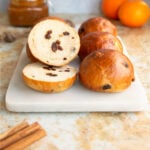



jenny paulin says
ooooh i do love a sticky fruit bun even better that they are fragranced with festive spices AND they can be slathered in butter!!! mmmmm would be perfect for breakfast with a cuppa (can you tell i am hungry!!??)
yum! they look greeeat x
Zahrah Ahmed says
Hi this looks promising but do you think I can sub all purpose flour for the bread flour? And what exactly is fast paced yeast? Is it the same as active dryand can that be used it instead as that’s all that I have.
Emily Leary says
Hi. Bread flour, also knows as strong flour, has a higher gluten content than all purpose flour. If you use all purpose flour, you won't get as strong a gluten structure, meaning the bread won't rise as well, or have as good a texture.
Fast action yeast is another name for instant yeast. It is not the same as Active Dry Yeast but you can substitute one for the other, you just need to adjust things slightly. Here is a good conversion resource.
As this recipe calls for 1 ½ tsp of fast action/instant yeast, to use active dried yeast you'd need to use 2 1/4 tsp.
You'd also need to 'activate' your active dried yeast (I know the name is confusing!) because this type can't be added direct to to the flour. Instead, you'll need to put it in a small bowl and add a tsp of sugar and a tablespoon of warm (not hot) milk. Stir and leave for 10 minutes - you should see bubbles. Then you can add your yeast mixture with the other wet ingredients to continue the recipe as normal.